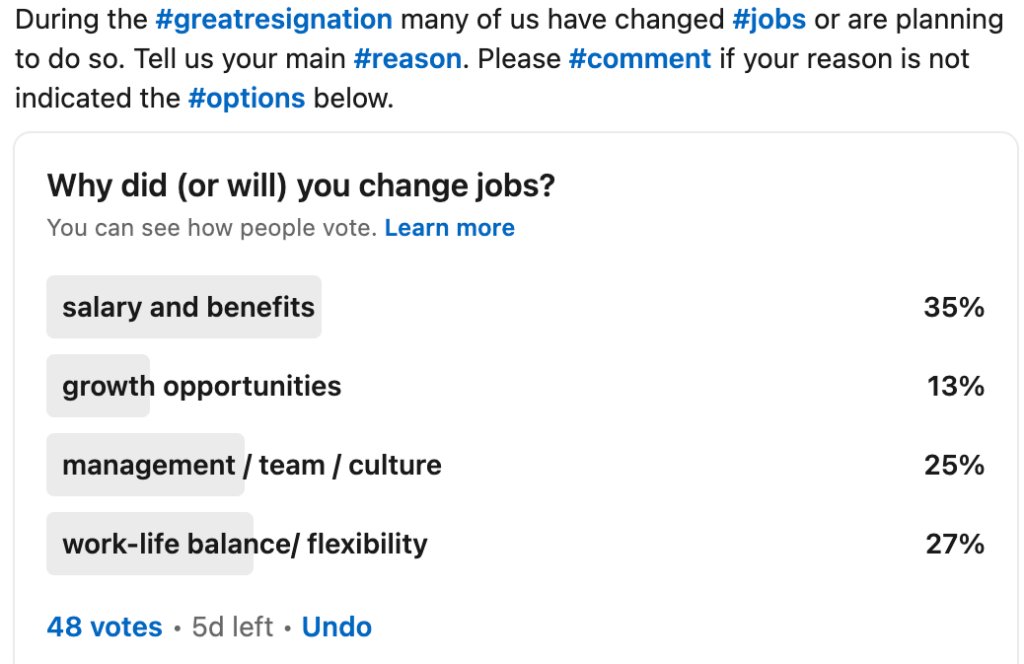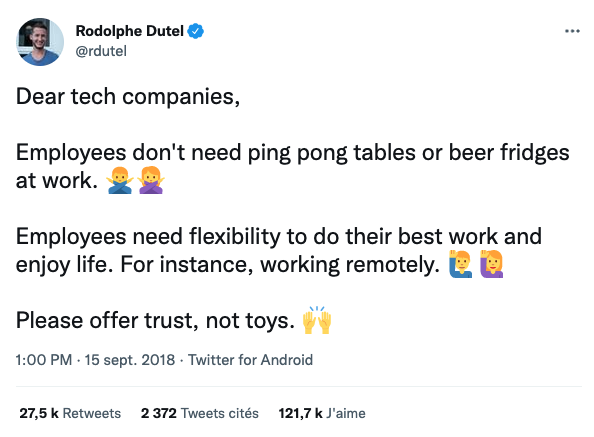The shortage of skilled workers has been rising continuously in recent years. To be able to hire and retain scarce talent, we need to improve the quality and speed of the hiring process. Here’s how we do that at madewithlove.
I. Finding talent
1. Take care of your job description.
Every hiring process starts with a job description. To make your job advert stand out from a million others, it should be well written, correct, and precise (tasks and expectations are clearly listed).
“What the hell is Larawell?” any PHP developer reading a poorly written job description
Not only do typos in the tech stack look unprofessional, but some people also may simply not find your advert when applying a search filter. Most role descriptions are not written by engineers, but HR, marketing, or other professionals.
If you are taking notes to prepare the content, conduct a thorough spell check (this includes looking up each technology you’ve never heard of) and get the final copy validated by the stakeholders you are hiring for (e.g. Tech Lead / CTO).
2. Explore new hunting grounds.
If you are used to hiring developers, you may already know some good job boards. However, it doesn’t hurt to shop around and try out something new every now and then. The results can be surprising!
We recently tested a new job board that was completely unknown to us beforehand and found some highly skilled people. Our client even hired one of the applicants we sourced from there!
3. Don’t leave the job to amateurs.
It’s fairly rare that A-developers are hired by C-recruiters. So don’t try to save costs by delegating a strategic task like hiring to someone who has never hired a developer before. Candidates will notice when someone does not know the difference between JavaScript and Java.
As a result, applicants may get the impression that they are wasting their time with someone who doesn’t know the business.
Good candidates often receive more than one offer and mostly base their decision on the impression they had of the company during the hiring process. Your recruiter (or recruitment agency) plays a vital role in this process.
4. The war for talent is, in fact, a race.
In a race, the fastest wins. Time to hire is more crucial than ever, and those who run the extra mile quickly will catch the fish. It is more than understandable that you want several opinions about a candidate you hire, but you may want to get them within a few days.
Make an offer as soon as you can!
If you have doubts about hard skills, these can always be improved — if the candidate is willing to learn.
5. Don’t ignore red flags.
The above, however, does not mean that you should ignore red flags when it comes to the person’s people skills.
If a candidate is unfriendly, arrogant, or unprofessional, your decision can be made on the spot. No matter how hard it is to find people, never hire someone who may poison your workplace, no matter how good they are on the technical side.
One bad apple in the basket may spoil your entire team, eventually resulting in more hiring needs because people will start resigning. We have a strict “No Assholes” policy at madewithlove.
6. Think out of the box.
I recently interviewed a former business analyst who had changed careers (by completing a coding bootcamp, followed by an internship).
She seemed motivated, smart, and displayed good technical knowledge and common sense. Her technical assignment result confirmed that she was a junior candidate, so we recommended her to a client.
They happened to pass, so I suggested her to another client who was looking for a medior developer, despite the fact that they were aiming to hire someone with a minimum of 3 years experience. The second client hired her a few days later.
In another case, we recently managed to find candidates for a senior .NET role. After hunting in Belgium returned few results, we extended the talent pool by targeting candidates based in countries outside of the EU and offered help with relocation.
7. Use an agile hiring process.
One of the pillars of an agile workflow is regular communication between stakeholders — in this case, between the hiring manager and the tech lead.
Check-in with your tech department once a week to inform them what has been done and which results from these actions have been produced. Ask for feedback, and if the results are insufficient, do not hesitate to make suggestions about how they can be improved. For example:
- Which requirements can be neglected or downgraded to nice-to-haves? The three years of experience mentioned above turned out to be optional.
- How can the talent pool be extended? Do people really need to come to the office three times per week?
- Find out the main reason why candidates turn down the offer and fix them! Is the salary too low? Is the title misleading?
8. D&I starts at the edge of your comfort zone.
Ask yourself who you cannot see fitting in with your team and why. Is it a neurodivergent person? Someone over 50? The only woman in a men’s club?
If you believe that anyone would feel uncomfortable working with your team, challenge your belief. Interview a person who is different and ask them how they would feel about working there (e.g. if they are older, how they would like working with a bunch of millennials). You may be surprised by the answer.
By the way, as one out of 2 women working in a team of mostly men, I’m speaking of my own experience: we surely do not mind all the extra attention 😉
II. Retaining talent
If your company is growing, hiring is the logical consequence.
It’s a less natural and rather unpleasant experience if you need to replace people frequently due to turnover. The recent great resignation brought back a vivid discussion about why people quit.
Some main reasons appear to be common to all markets and industries (an interesting read about the US market is found here; the job board Glassdoor also presented their top 10 list). To get an idea about how things are in the tech industry, we conducted a brief survey on Linkedin (certainly not large enough to be representative, but still interesting to see):

Out of the 48 people who answered,
- 35% changed jobs for monetary reasons – salary and benefits
- 27% were seeking a better work-life balance/flexibility
- 25% of job changes were people-related (Management / team / work culture)
- Surprisingly, only 13% left for growth opportunities*
(* These numbers are quite different from what we hear during interviews: candidates often mention that they want to change jobs because they want to learn something new. In reality, no one with a modicum of common sense will say that they quit because their boss was a jerk.)
Other reasons that were often mentioned during interviews:
- Company-related (bankruptcy or endangered job security)
- Job-related (e.g. a discrepancy between the job and the candidate’s personal goals, often a reason to quit shortly after starting a new role or after being given new tasks due to internal restructuring)
- Personal (career change, relocation)
For our recent LinkedIn poll, financial reasons (salary and benefits, 35%) were the most popular choice. When working for the same salary as last year, employees are effectively making 5-10% less than 12 months ago due to the current inflation.
No surprise: Companies who pay a “loyalty bonus” to their employees in the form of an annual pay raise do better in retaining talent.
The 2nd most important factor for retention is the work-life balance and flexibility (27%): Most of today’s workers are aware of just how detrimental a lack of work-life balance can be. Either they experienced burnout themselves or saw others suffering the consequences of constant stress and know that this is not what they want (anymore).
Flexible working hours and recuperating over time make life easier. Working from home is something that people do not want to forego anymore.
→ If you want to keep your workers, let them do the job where and when they want, and they will pay it back to you by staying on board and staying fresh!
Read about madewithlove’s policy

Another 25% changed jobs because of management/team/culture.
Poor management and a toxic work environment chase away the most talented people: Those who are confident and skilled enough to try their luck elsewhere will do so.
This will eventually lead to a negative selection: the highest performers will leave while (due to lack of confidence or opportunities) underperformers stay.
I have a friend who was one of the best-performing sales representatives in her team, but she resigned because the company’s micromanagement killed her motivation.
She cited that most of the company’s recent hires left for the same reason, but some of the lowest performers stayed on board for several more years.
Although they may not always be the number 1 reason, growth opportunities (13%) are most mentioned during interviews, along with the desire to work with modern technologies.
Working with an outdated tech stack or “homegrown” software, no one will ever need results again in a dead end because these skills cannot be capitalized on.
Therefore, no one wants to work with dinosaur technologies unless they are perhaps just a few months away from retirement and thus couldn’t care less.
→ Consider hiring when making technical / make or buy choices: is this a technology that will attract talent or one that will push people to leave?
Managing culture through hiring and retention
How good a job do you do? Consider that employees may not always be straightforward. You may want to bring in someone impartial to get some honest answers. While madewithlove’s audits already cover some management aspects and risks, some HR consultants offer employer branding audits.
Focusing on retaining talent can help reduce your hiring needs (and costs) significantly. While some turnover is normal and foreseeable (such as personal reasons), identify and remedy sources of frustration within a team.
Hiring itself needs to be approached in a much more focused manner than 10 or 15 years ago. Agile processes and highly specialized recruiters can make a big difference here. Reach out if you’d like to close that gap.










Member discussion